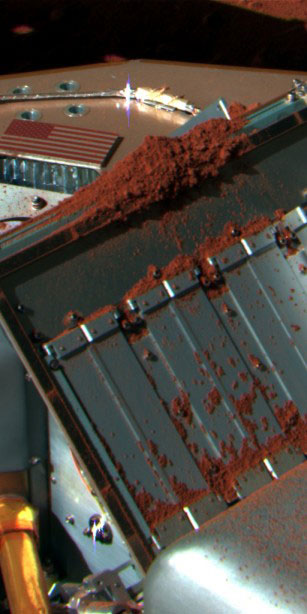Mars Lander Gets Another Sample In Oven

NASA's Phoenix Mars Lander has successfully dumped another sample of surface dirt into its ovens for analysis, mission scientists reported this weekend.
Phoenix's robotic arm delivered dirt Thursday from a trench informally named "Rosy Red" through a narrow opening to a screen above the No. 5 oven on the lander's Thermal and Evolved-Gas Analyzer (TEGA). TEGA heats up the samples in its oven and then analyzes the vapors given off to help determine the composition of the Martian dirt.
The $420 million Phoenix mission is designed to analyze the surface dirt and underlying ice in the arctic regions of Mars to assess whether or not the area might have been habitable at some point in the past.
A few particles of the sample passed through the screen on Thursday, but not enough to fill the oven and allow analysis of the sample to begin. The Phoenixteam sent commands for TEGA to vibrate the screen again on Friday, and more material reached the oven, though still not enough to proceed with analysis.
"There appear to be clumps blocking the opening," said Phoenix science lead Doug Ming of NASA Johnson Space Center, in Houston, on Friday.
Vibration of the screen on Saturday finally succeeded in getting enough dirt into the oven to begin analysis. The team sent instructions to begin analysis of the sample on Sunday.
Phoenix scientists will be looking for signs of perchlorate, a highly oxidizing substance that was detected in dirt samples by the lander's wet chemistry laboratory. The last sample analyzed by TEGA found no indications of any chlorine present
Breaking space news, the latest updates on rocket launches, skywatching events and more!
On Friday, the spacecraft also extended the width of an exploratory trench informally named "Neverland," which runs between two rocks on the surface of the ground.
Phoenix also took overnight measurements of the conductivity of the Martian regolith that were completed on Wednesday. A fork-like probe inserted into the dirt checks how well heat and electricity move through the dirt from one prong to another.
Phoenix's mission, originally slated to end at the end of August, has been extended to Sept. 30.

Andrea Thompson is an associate editor at Scientific American, where she covers sustainability, energy and the environment. Prior to that, she was a senior writer covering climate science at Climate Central and a reporter and editor at Live Science, where she primarily covered Earth science and the environment. She holds a graduate degree in science health and environmental reporting from New York University, as well as a bachelor of science and and masters of science in atmospheric chemistry from the Georgia Institute of Technology.
